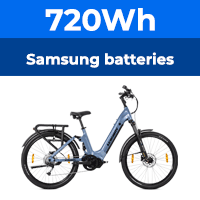Hi,
I am building a LiPo 7S bike battery charger. Rather than taking the conventional approach of charging the bank from its two ends and bleeding individual cell banks if they rise above the average, I want to charge all cell banks individually with a TP4056 or similar charge controller.
I am providing isolated/floating 5V for each controller by using 7 Wall wart USB chargers. This means I can connect them in series without shorting anything.
This works but - because of the large almost-flat voltage part of the LiPo charge curve - the charge controller is extremely sensitive to the sensed battery voltage and will throttle back the charging current greatly if even a tiny rise in battery voltage is detected. This is of course, doing what it's meant to do. However, if I try to charge through the balance charging leads, which are thin and high resistance, the controller takes forever trickling in charge, because these balance leads drop significant voltage for reasonable charge currents. They were never meant to carry charge current - only to sense voltage at no current - so again, all is as it should be. So I want to replace them with beefier low-resistance cables which can feed higher charging currents without dropping voltage - so the charge controller can sense each cell bank's charge state more accurately and charge as fast as possible.
BUT this approach is dangerous. If the charge controller fails short-circuit then a cell bank is shorted out and the thicker wires will not blow so the whole battery could burn up.
Fuses would be the obvious approach - a fuse in each charge line. The problem is that these also drop significant voltage so we're back with very slow charging.
I suppose I could fit Hall effect sensors and relays and add a microcontroller to sense the current and turn off the relay if current becomes too high (or probably hold ON the relay as long as current is NOT too high) but this adds a great deal of complexity.
So my question is - is there an easier/cheaper/better way to provide this protection?
Any other comments on this proposal are also welcome.
Thanks
Chris
I am building a LiPo 7S bike battery charger. Rather than taking the conventional approach of charging the bank from its two ends and bleeding individual cell banks if they rise above the average, I want to charge all cell banks individually with a TP4056 or similar charge controller.
I am providing isolated/floating 5V for each controller by using 7 Wall wart USB chargers. This means I can connect them in series without shorting anything.
This works but - because of the large almost-flat voltage part of the LiPo charge curve - the charge controller is extremely sensitive to the sensed battery voltage and will throttle back the charging current greatly if even a tiny rise in battery voltage is detected. This is of course, doing what it's meant to do. However, if I try to charge through the balance charging leads, which are thin and high resistance, the controller takes forever trickling in charge, because these balance leads drop significant voltage for reasonable charge currents. They were never meant to carry charge current - only to sense voltage at no current - so again, all is as it should be. So I want to replace them with beefier low-resistance cables which can feed higher charging currents without dropping voltage - so the charge controller can sense each cell bank's charge state more accurately and charge as fast as possible.
BUT this approach is dangerous. If the charge controller fails short-circuit then a cell bank is shorted out and the thicker wires will not blow so the whole battery could burn up.
Fuses would be the obvious approach - a fuse in each charge line. The problem is that these also drop significant voltage so we're back with very slow charging.
I suppose I could fit Hall effect sensors and relays and add a microcontroller to sense the current and turn off the relay if current becomes too high (or probably hold ON the relay as long as current is NOT too high) but this adds a great deal of complexity.
So my question is - is there an easier/cheaper/better way to provide this protection?
Any other comments on this proposal are also welcome.
Thanks
Chris








